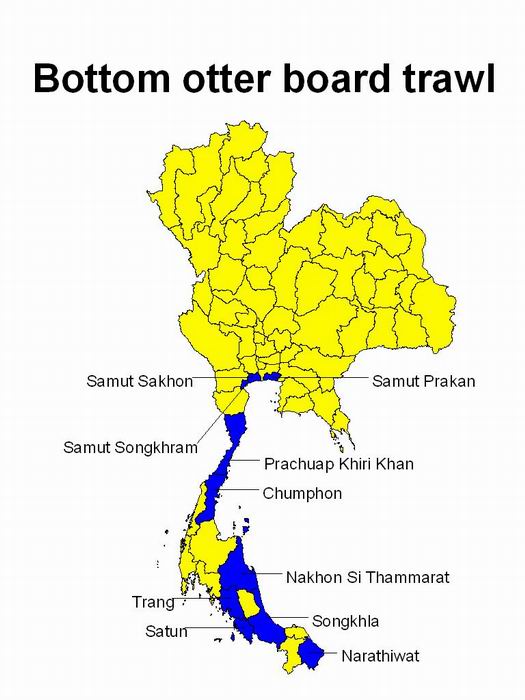Otter Trawl
The
most popular form of trawl fishing in Thailand is by otter
trawl, in which otter boards are used for horizontal spreading
of the net mouth. Most otter trawl nets consist of two panels;
this is called a “two-seam net”. The mouth
is oval-shaped when viewed from front. Two wings stretch
out to increase the swept area and to guide fish in the net’s
path down to the cod-end. There are two typed of otter
trawl: one for shrimps and the other for fish.
The
otter trawl for shrimp is usually operated from small fishing
boat, 8-16 m in length and with the low to medium power of
the main engine (30-120 h.p.). The netting is 30-60
mm mesh-size, polyethylene 250 d/6 or 380 d/6-12 for the
wings, upper panel and the belly, and 20-25 mm mesh-size
polyethylene 380 d/9-15 for the cod-end. In most cases,
the triangular piece of netting at the top wings of both
panels is omitted. The size of net depends on the power
of the fishing boat; the head-rope varies from 11-23 m and
the ground-rope from 13-24 meters. The difference between
them is 1-2 meters. Both are made of polyethylene or
polypropylene. The ground rope is weighted with a chain,
or with lead sinkers. Otter-boards are rectangular
and flat, made of wood and iron, 50-100 cm wide and 100-200
cm long, with a bridle chain and a back strap. The
sweep lines or hand-ropes are10-36 m long, 14-26 mm in diameter,
made of polyethylene, polypropylene or a combination rope.
The
warps are 14-28 mm in diameter, also made of polyethylene
or polypropylene. A capstan winch is used for hauling
warps and lifting the catch in the cod-end onto the foredeck
of the fishing boat. The net is pulled by hand at stern. Four
to eight fishermen take part in a fishing operation. The
shrimp otter trawls are mostly operated from Nakhon Si Thammarat
to Songkhla province, and the catches consist of shrimps
and trash-fish.
The
fish otter trawls are the largest single fishery in Thailand. Most
vessels used in this case are comparatively big, from 15
to over 30 m in length, with the main engines ranging from
100 to 500 h.p. The fishing expeditions take one or
two weeks, sometimes even longer. The two-seam type
of net is used, 120-180 mm mesh-size, polyethylene 700 d/12-21
netting for the wings, square, upper panel and belly, and
20-30 mm mesh-size polyethylene 380 d/9-15 netting for the
cod-end. This net differs from the shrimp otter trawl
net in that it has a triangular piece of netting at the top
wings of both panels. The head rope is 28-40 m, and
the ground rope 30-46 m long. The difference in their
lengths is 2-6 metres. Both ropes are made of wire
and combination rope. Wooden and rubber rollers, sometimes
covered with spherical plastic capsul are attached on the
ground rope for weighting and nothing. Otter-boards
are rectangular and flat, 1-2 m wide, 1.2 x 2.4 m long, made
of wood and iron. They have a fixed bracket and a bridle
chain or fixed iron holders, and sometimes 1-5 plastic floats
are attached at the front top part of the boards, so as to
prevent the sinking of the boards into the muddy sea bed. Gallows,
which are necessary for this type of trawl, are fixed at
the stern of the boat. The necessary for this type
of trawl, are fixed at the stern of the boat. The
sweep lines or hand-ropes are 35-80 m long, 22-32 mm thick
combination ropes. The warps are 14-18 mm thick wires,
coiled on the warp drum winches on both sides of the boat,
or in the middle of a stern trawler. Warps are hauled
by a warp drum winch, the net is pulled by a capstan winch,
and passes through a pulley on the crane boom at the fore-deck
(or stern-deck of a stern trawler). The cod-end is
hauled in the same way. Ten to twenty men are needed
for a fishing operation. The main catch are bottom
fishes and trash-fish. The major fishing ports are
Samut Prakan, Samut Sakhon, Songkhla and Phuket.
Setting:
When the gear is to be prepared, the boat streams along the
desired bourse, into wind if desirable. The codend
is thrown out and the working ropes retied in their correct
positions on head line and wings and the net streamed out
astern, the sweep lines run out. The otter boards are
connected to the warps and unhooked from the gallows, all
is ready for setting.
This
may be accomplished by releasing the winch brakes simultaneously
so allowing the otter boards to drop into the water and spread
while “on the run” or alternatively the warps
may first be eased out until the otter boards are just below
the surface and seem to be spreading satisfactorily before
the warps are released.
All
is now ready to set the otter boards and run out the warps
to their required extent.
Hauling: When
hauling, the otter boards are hove up to the gallows and lift
hanging on the warps, being clamped if necessary to prevent
slamming. The sweep lines were wound by winch to the
ground rope. Then the ground ropes, wings and bellies
of the trawl also are hauled up to the stern and the codend
is pulled tot he fore deck for emptying.

|